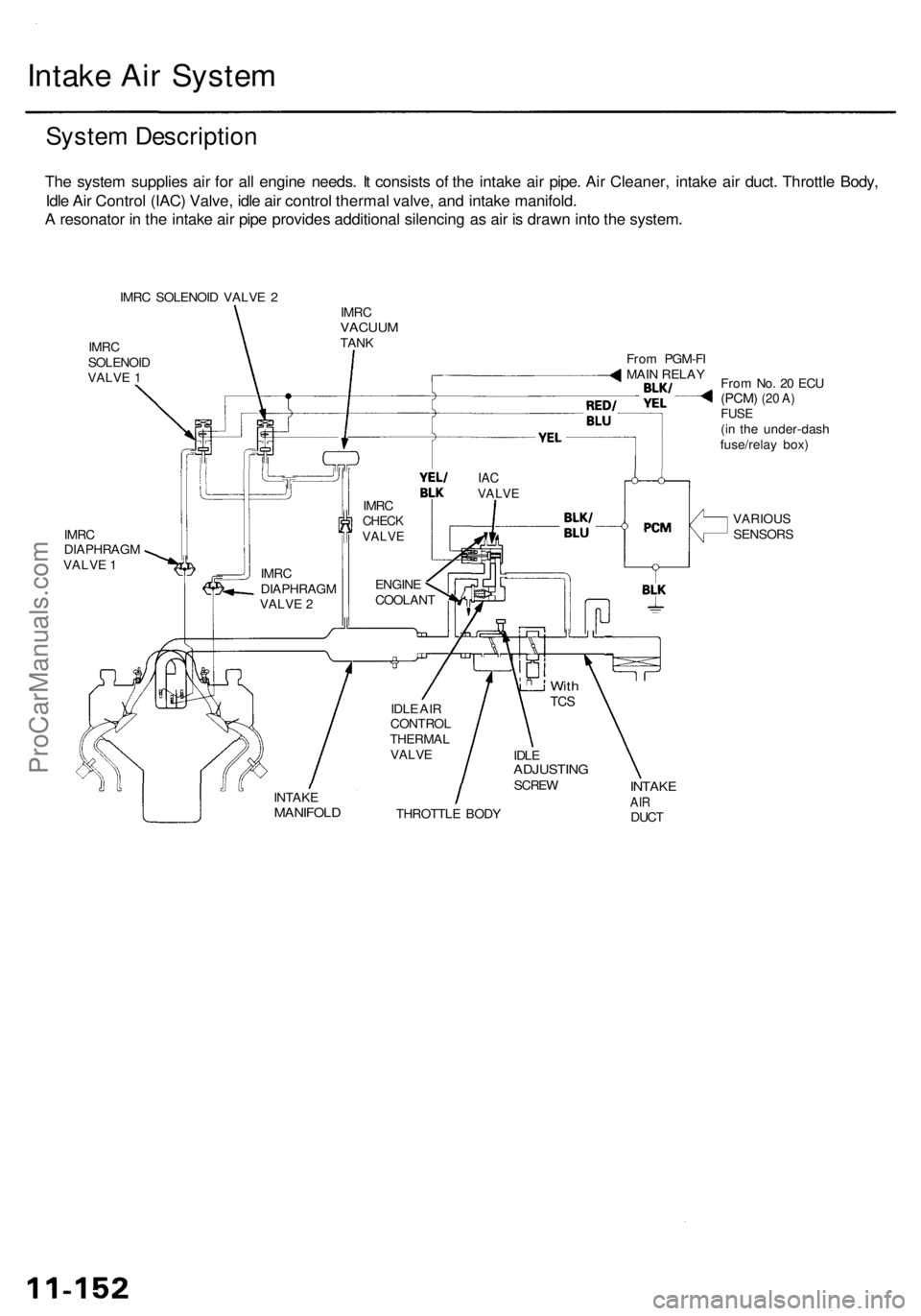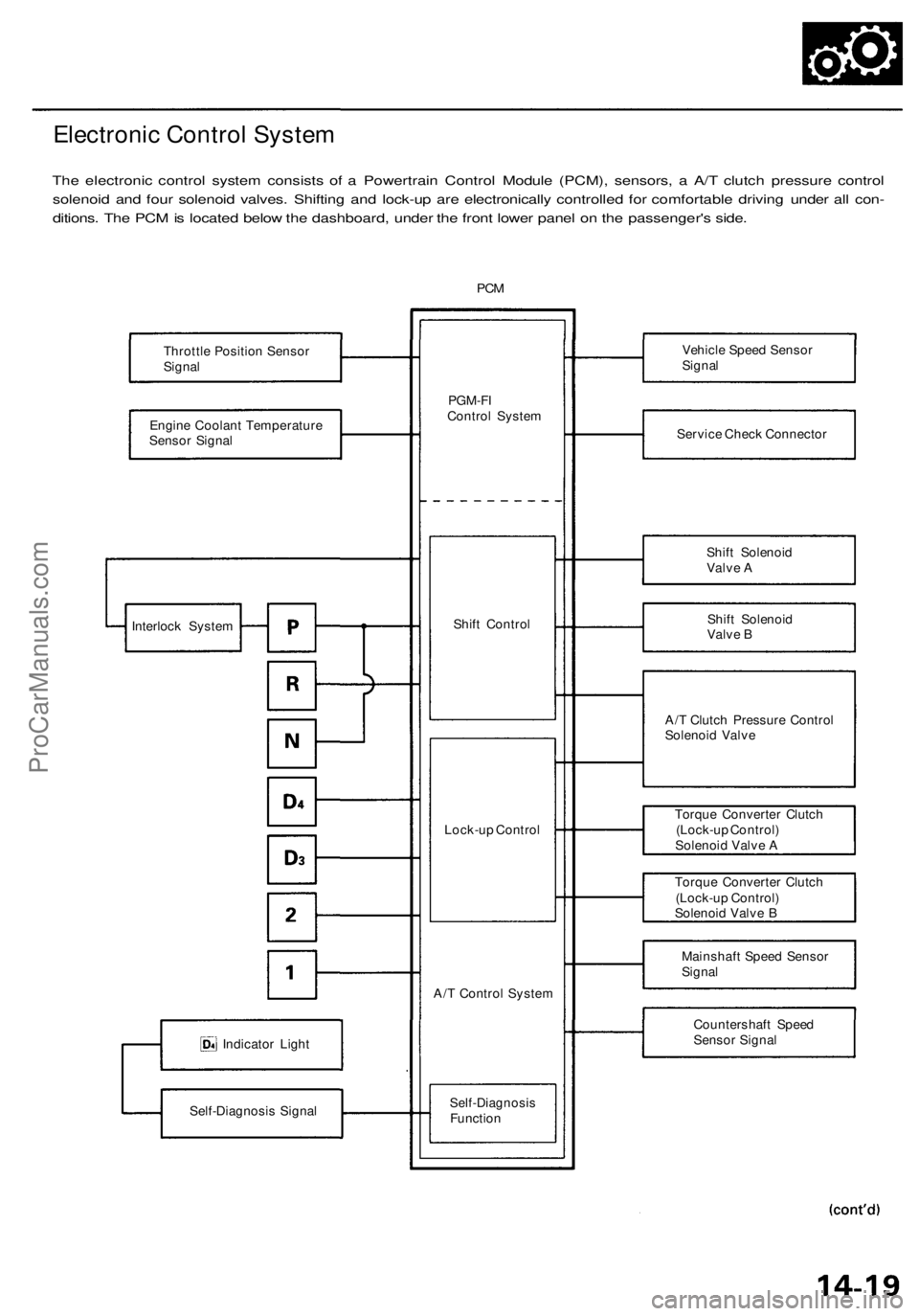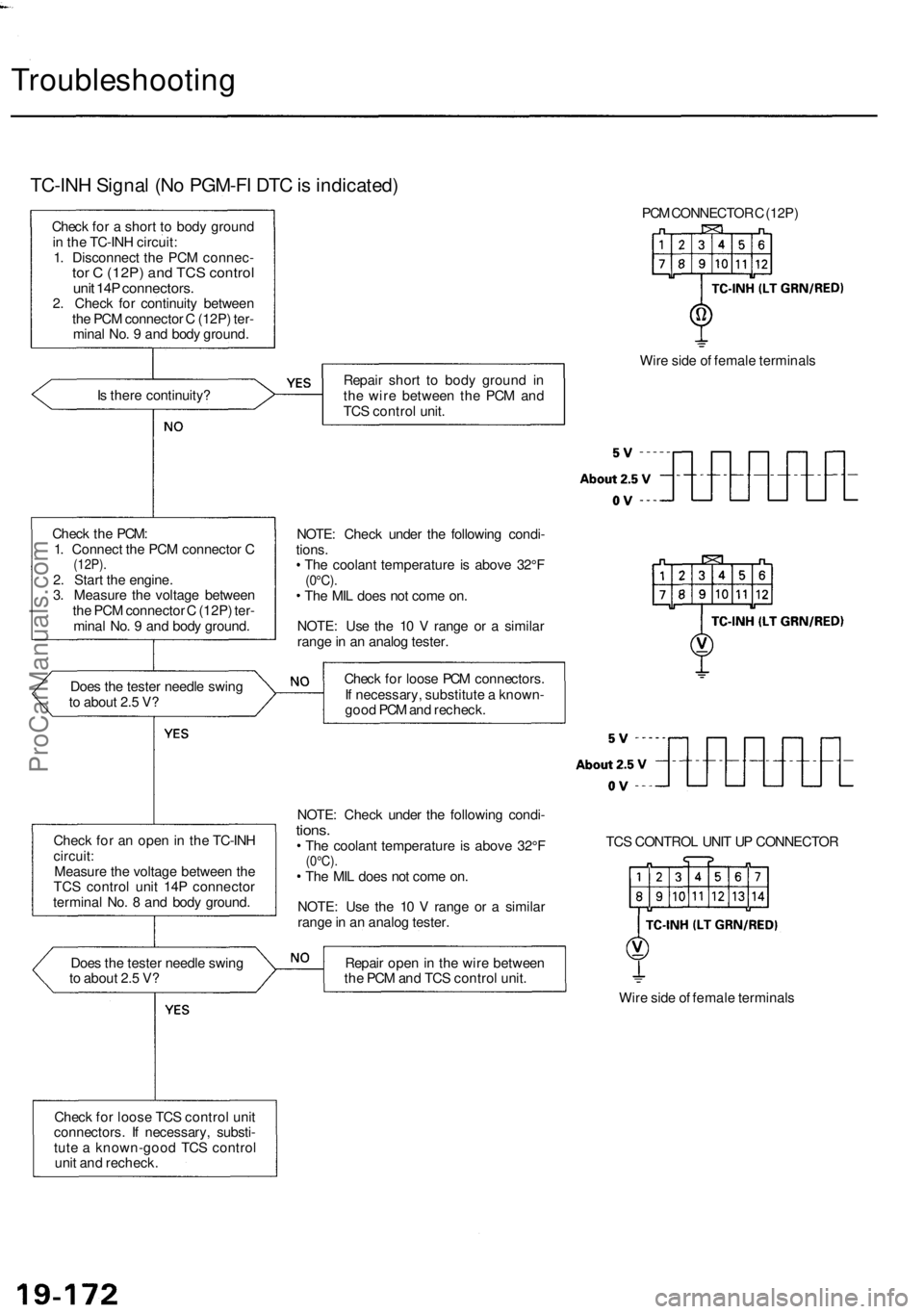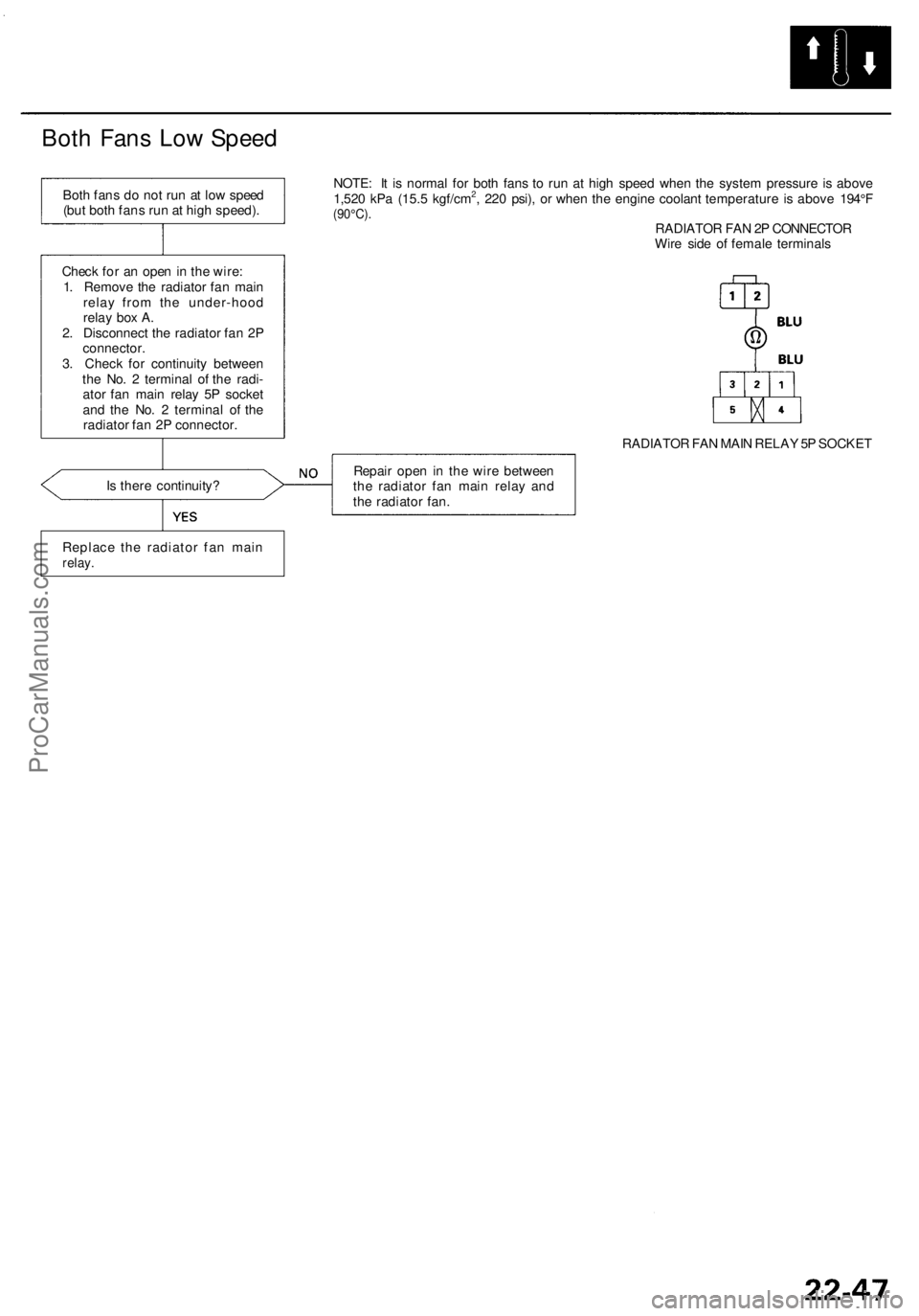engine coolant ACURA RL KA9 1996 Service User Guide
[x] Cancel search | Manufacturer: ACURA, Model Year: 1996, Model line: RL KA9, Model: ACURA RL KA9 1996Pages: 1954, PDF Size: 61.44 MB
Page 544 of 1954

PCM Data
You can retrieve data from the PCM by connecting the OBD II scan tool or the Honda PGM Tester to the Data Link
Connector (DLC). The items listed in the table below conform to SAE recommended practice. The Honda PGM Tester also
reads data beyond that recommended by SAE so that this data may help you find the causes of intermittent problems.
NOTE:
• The "operating values" listed are approximate and may vary depending on the environment and the individual vehicle.
• Unless noted otherwise, "at idle speed" means idling with the engine completely warmed up, transmission in Park or
neutral, and the A/C and all accessories turned off.
Data
Description
Operating Value
Freeze Data
Diagnostic
Trouble Code
(DTC)
If the PCM detects a problem, it will store it as a code
consisting of one letter and four numbers.
Depending on the problem, an SAE-defined code
(P0xxx)
or a
Honda-defined code
(P1xxx)
will
be
output
to the tester.
If no problem is detected,
there is no output.
YES
Engine Speed
The PCM computes engine speed from the signals sent
from the Crankshaft Position (CKP) sensor.
This data is used for determining the time and amount
of fuel injection.
Nearly the same as
tachometer indication at
idle speed:
650 ± 50 rpm
YES
Vehicle Speed
The PCM converts pulse signals from the Vehicle
Speed Sensor (VSS) into speed data.
Nearly the same as
speedometer indication
YES
Manifold
Absolute
Pressure (MAP)
The absolute pressure created in the intake manifold by
engine load and speed.
With engine stopped:
Nearly the same as atmo-
spheric pressure.
At idle speed:
24 - 37
kPa
(180
-
280
mmHg, 7.1 - 11.0 inHg)
YES
Engine Coolant
Temperature
(ECT)
The ECT sensor converts coolant temperature into
voltage and signals the PCM. The sensor is a thermistor
whose internal resistance changes with coolant
temperature. The PCM uses the voltage signals from
the ECT sensor to determine the amount of injected
fuel.
With cold engine:
Same as ambient temper-
ature and IAT
With engine warmed up:
approx. 158 - 212°F
(70 - 100°C)
YES
Heated Oxygen
Sensor (HO2S)
(Bank 1, Sensor 1)
(Bank 2, Sensor 1)
(Sensor 2)
The HO2S detects the oxygen content in the exhaust
gas and sends voltage signals to the PCM. Based on
these signals, the PCM controls the air/fuel ratio. When
the oxygen content is high (that is, when the ratio is
leaner than the stoichiometric ratio), the voltage signal
is lower. When the oxygen content is low (that is, when
the ratio is richer than the stoichiometric ratio), the
voltage signal is higher.
0.0 -
1.25
V
At idle speed:
about 0.1 - 0.9 V
NOProCarManuals.com
Page 656 of 1954

Intake Air System
System Description
The system supplies air for all engine needs. It consists of the intake air pipe. Air Cleaner, intake air duct. Throttle Body,
Idle Air Control (IAC) Valve, idle air control thermal valve, and intake manifold.
A resonator in the intake air pipe provides additional silencing as air is drawn into the system.
IMRC SOLENOID VALVE 2
IMRC
SOLENOID
VALVE 1
IMRC
VACUUM
TANK
From No. 20 ECU
(PCM)
(20 A)
FUSE
(in the under-dash
fuse/relay box)
IMRC
DIAPHRAGM
VALVE 1
VARIOUS
SENSORS
THROTTLE BODY
INTAKE
AIR
DUCT
INTAKE
MANIFOLD
IDLE
ADJUSTING
SCREW
With
TCS
IDLE AIR
CONTROL
THERMAL
VALVE
IAC
VALVE
From PGM-FI
MAIN RELAY
IMRC
DIAPHRAGM
VALVE 2
IMRC
CHECK
VALVE
ENGINE
COOLANTProCarManuals.com
Page 728 of 1954

Electronic Control System
The electronic control system consists of a Powertrain Control Module (PCM), sensors, a A/T clutch pressure control
solenoid and four solenoid valves. Shifting and lock-up are electronically controlled for comfortable driving under all con-
ditions. The PCM is located below the dashboard, under the front lower panel on the passenger's side.
PCM
Throttle Position Sensor
Signal
Engine Coolant Temperature
Sensor Signal
Indicator Light
Self-Diagnosis Signal
PGM-FI
Control System
Shift Control
Lock-up Control
A/T Control System
Self-Diagnosis
Function
Vehicle Speed Sensor
Signal
Service Check Connector
Shift Solenoid
Valve A
Shift Solenoid
Valve B
A/T Clutch Pressure Control
Solenoid Valve
Torque Converter Clutch
(Lock-up Control)
Solenoid Valve A
Torque Converter Clutch
(Lock-up Control)
Solenoid Valve B
Mainshaft Speed Sensor
Signal
Countershaft Speed
Sensor Signal
Interlock SystemProCarManuals.com
Page 730 of 1954

Grade Logic Control System
How it works:
The PCM compares actual driving conditions with driving conditions memorized in the PCM, based on the input from the
vehicle speed sensor, throttle position sensor, engine coolant temperature sensor, barometric pressure sensor, brake
pedal position switch signal and shift lever position signal, to control shifting while a vehicle is ascending or descending a
slope.ProCarManuals.com
Page 1211 of 1954

Troubleshooting
TC-INH Signal (No PGM-FI DTC is indicated)
Check for a short to body ground
in the TC-INH circuit:
1. Disconnect the PCM connec-
tor C (12P) and TCS control
unit 14P connectors.
2. Check for continuity between
the PCM connector C (12P) ter-
minal No. 9 and body ground.
Is there continuity?
Check the PCM:
1. Connect the PCM connector C
(12P).
2. Start the engine.
3. Measure the voltage between
the PCM connector C (12P) ter-
minal No. 9 and body ground.
Does the tester needle swing
to about 2.5 V?
Check for an open in the TC-INH
circuit:
Measure the voltage between the
TCS control unit 14P connector
terminal No. 8 and body ground.
Does the tester needle swing
to about 2.5 V?
Check for loose TCS control unit
connectors. If necessary, substi-
tute a known-good TCS control
unit and recheck.
PCM CONNECTOR C (12P)
Repair short to body ground in
the wire between the PCM and
TCS control unit.
Wire side of female terminals
NOTE: Check under the following condi-
tions.
The coolant temperature is above 32°F
(0°C).
The MIL does not come on.
NOTE: Use the 10 V range or a similar
range in an analog tester.
Check for loose PCM connectors.
If necessary, substitute a known-
good PCM and recheck.
NOTE: Check under the following condi-
tions.
The coolant temperature is above 32°F
(0°C).
The MIL does not come on.
NOTE: Use the 10 V range or a similar
range in an analog tester.
TCS CONTROL UNIT UP CONNECTOR
Repair open in the wire between
the PCM and TCS control unit.
Wire side of female terminalsProCarManuals.com
Page 1462 of 1954

Both Fans Low Speed
Both fans do not run at low speed
(but both fans run at high speed).
Check for an open in the wire:
1. Remove the radiator fan main
relay from the under-hood
relay box A.
2. Disconnect the radiator fan 2P
connector.
3. Check for continuity between
the No. 2 terminal of the radi-
ator fan main relay 5P socket
and the No. 2 terminal of the
radiator fan 2P connector.
NOTE: It is normal for both fans to run at high speed when the system pressure is above
1,520 kPa (15.5 kgf/cm2, 220 psi), or when the engine coolant temperature is above 194°F
(90°C).
RADIATOR FAN 2P CONNECTOR
Wire side of female terminals
RADIATOR FAN MAIN RELAY 5P SOCKET
Is there continuity?
Repair open in the wire between
the radiator fan main relay and
the radiator fan.
Replace the radiator fan main
relay.ProCarManuals.com